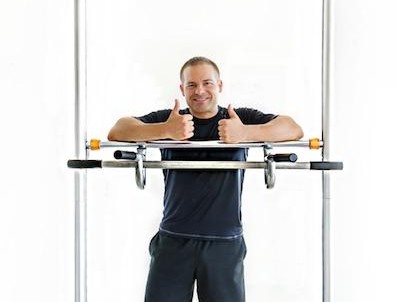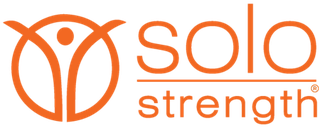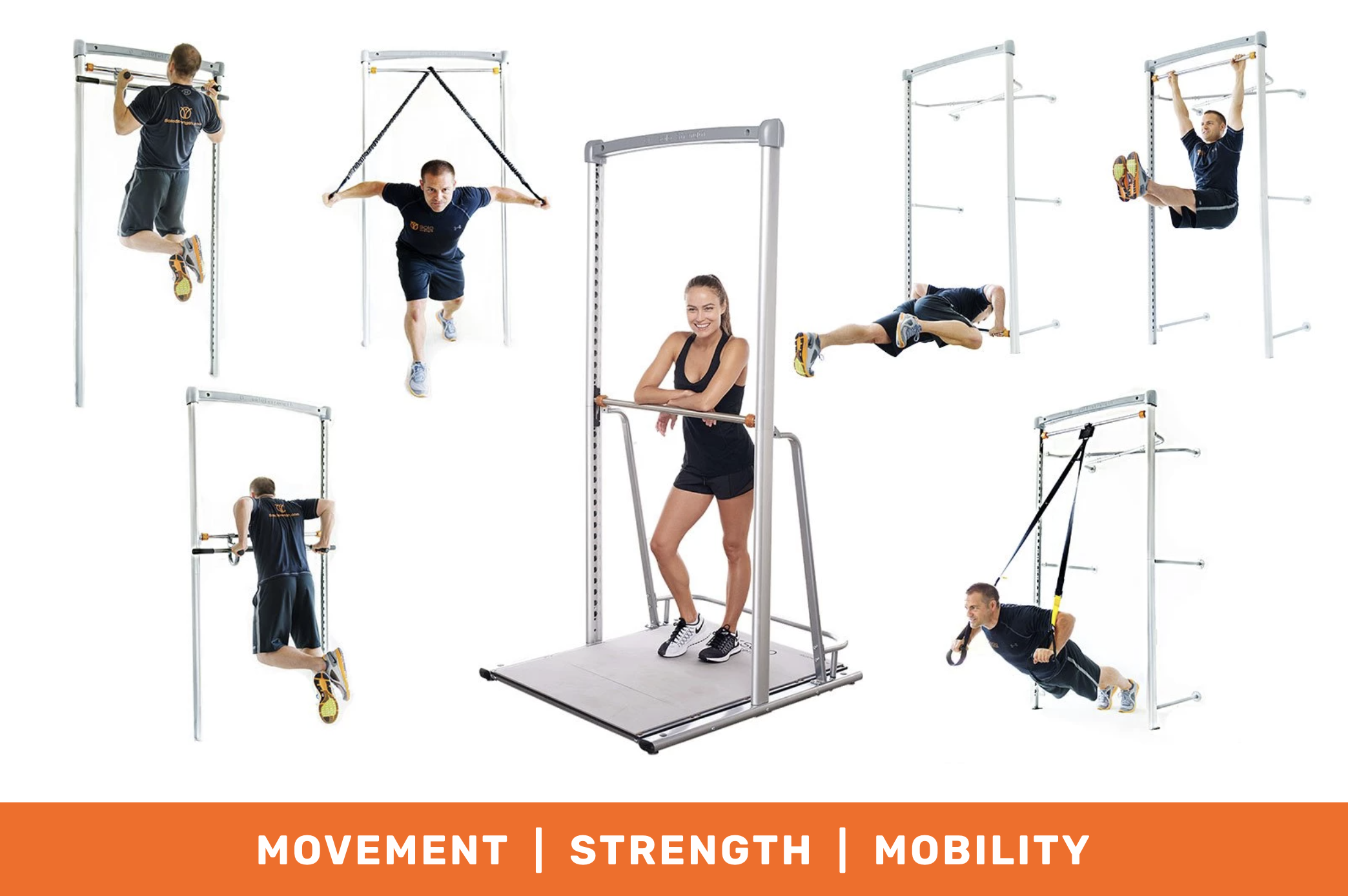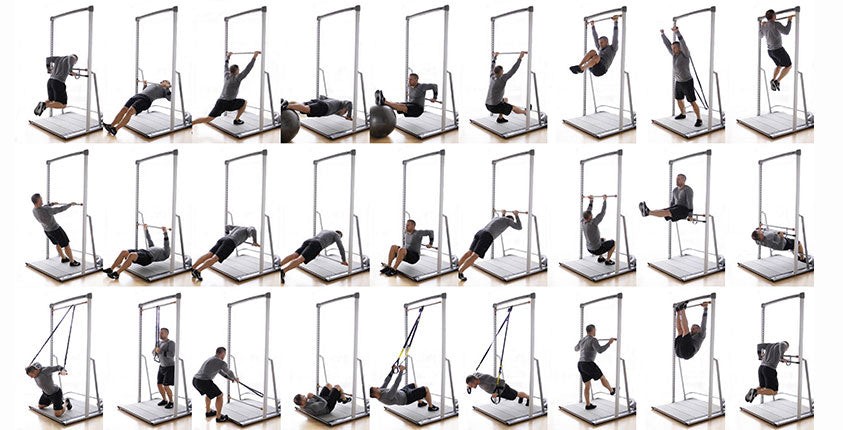EASIEST WAY TO LEARN HOW TO DO PULL UPS AND GET A STRONGER BACK
Choose Your Perfect Ultimate Training Station:
#1 Home/Studio Workout Systems
Easiest way to learn how to do pull ups and get a stronger back
Get a safe (preferably adjustable) Pull-Up Bar.
Where can you get an Adjustable Pull-Up Bar?
If you don't already have one, the first thing to do is get yourself a safe and adjustable pull up bar. There are many different options out there but here are some things to look for when buying one:
-
Make sure it can be mounted securely in place so that it doesn't fall down during use or while being moved around for storage. You don't want to be doing pull ups with a faulty/unstable bar!
-
Make sure that the mounting system is simple enough so that you can install it in your home without needing professional assistance (most people don't have this option). If not, then look into hiring someone who has experience installing these types of products (this could cost between 50-100 USD depending on where you live).
Start With Inverted Rows.
First and foremost, the easiest way to learn how to do pull ups is by starting with inverted rows. An inverted row is a bodyweight exercise that targets your back muscles by bending over a bar and pulling yourself upward until your chest reaches the bar. It's easier than it looks, and can be done with assistance or resistance bands or even better with an adjustable exercise pull up bar (see below).
After you've mastered inverted rows on an adjustable height exercise bar or other sturdy surface like monkey bars at the park, it's time for assisted pull ups. This means that someone else helps you lift yourself up while you perform the movement—and then they let go so that only your own strength is supporting your weight as you lower yourself back down again. Once this becomes easy enough for you, try using resistance bands around your waist as added support during these same assisted pull ups; this will reduce some of the strain on your arms and hands since there'll be less weight pulling down on them when working out against gravity alone.
Add a Lat Pulldown Machine or Adjustable Height Exercise Bar to Your Routine.
Lat pulldowns are another great exercise for beginners. They provide an easier way to work on your back muscles and upper body strength. These machines can be found at most gyms, or you can use a partner to help you by holding onto their ankles while they're standing up straight. It's also possible to do lat pulldowns with resistance bands, which will make the exercise less challenging for you as your body gets stronger (but it will still strengthen your back).
Lat pulldowns are compound movements so they'll improve multiple muscle groups at once—including your biceps and shoulders—which makes them perfect if you're trying to get stronger overall rather than just focusing on one muscle group at a time. You should start off with lighter weights until you feel comfortable doing this move before increasing them over time; try doing three sets of ten reps each day or every other day until it feels easy enough for you not only maintain but increase them again!
Add Resistance Bands to Your Routine.
Resistance bands are rubber tubes that come in a variety of sizes and resistance levels. They're inexpensive, and you can buy them at most sporting goods stores or online. These resistance bands stretch and contract as you pull or push on them; they add weight to your exercise without adding any bulk.
You can use resistance bands in many different types of workouts, but they're especially helpful when learning how to do pull ups because they provide extra resistance when you need it most—when your body moves through space (the top part of a pull up) or against gravity (the bottom part of a pull up).
To get started using resistance bands for this purpose:
-
Make sure that the length is long enough so that one end can be secured around something stable like a tree branch or door frame, while the other end stays loose with plenty of slack.
-
Position yourself under the band so it rests lightly across your shoulders just above your collar bone area - don't put all of its tension on that spot; rather distribute some around other areas like your shoulder blades if possible! This will allow for more versatility during different exercises as well as prevent injury from occurring due to uneven pressure being applied throughout each set performed throughout practice sessions."
Use an Assisted Pull-Up Machine.
-
Use an Assisted Pull-Up Machine.
-
IF you don't have a SoloStrength Training Pull Up Station and can easily adjust the height of the exercise pull up bar to self assist, you can try some of these methods below to learn pull ups.
When you're first starting out, it's best to use the assisted pull up machine at a height that allows you to perform 10-12 reps with good form. Once you've mastered 10-12 reps on this machine, move over to the lat pulldown machine, which provides more resistance and will help increase your strength for future workouts.
-
Use a Resistance Band for Assistance. A resistance band is another great way to gain strength in your back as well as improve your grip strength before trying an assisted pull up machine or lat pulldown machine. The band helps create tension in your upper body while doing chin ups or inverted rows so that each rep feels heavier than it would without assistance from the rubber band—which means less risk of injury and faster results!
-
Jump Up or Down From A Horizontal Surface For Added Challenge: Jumping up onto a horizontal bar will give added challenge by forcing you to use more muscle groups than just those in your arms alone; try jumping down instead of up if you find this easier!
Jumping Pull-Ups (Or Chin-Ups).
Jumping Pull-Ups (Or Chin-Ups).
This one is a bit of a cheat, but you can still get some benefit from it. The idea is to set yourself up on the pull up bar and then jump up to it, lowering yourself back down again. By jumping instead of using your arms and swinging or kipping, you are reducing the assistance your body provides to you in performing the exercise. This makes this variation more difficult than regular pull ups or chin ups because you're essentially doing them against gravity alone. If you want to make it even harder, try keeping your legs straight while doing these jumping pull ups!
To find out more about how this works with SoloStrength adjustable height exercise bar for progressive pull up exercises check out our article here: https://solostrength.com/blogs/powerplay-blog/new-adjustable-pull-up-bar-home-gym
Pull ups are one of the best ways to strengthen your back, shoulders and arms.
You may have reviewed some other references from Men's Health and Fitness and others about various ways to use a fixed height pull up bar or learning pull ups yourself...however by now, it should be very obvious to you that the best way to learn pull ups for anyone, and enjoy a huge range of bodyweight exercises in your home, is to find the best adjustable pull up bar dip station training station that allows you to do it all, faster, and more safely, so you can enjoy your best fitness lifestyle.
In closing, Pull ups are one of the best ways to strengthen your back, shoulders and arms. Pull ups are one of the most effective compound exercises for building strength in your back, shoulders and arms. The pull up works many muscles in your upper body as well as your core muscles.
The main muscle groups involved in a pull up exercise include:
-
Deltoid (shoulder)
-
Biceps brachii (upper arm)
-
Brachialis & Brachioradialis (upper arm)
-
Latissimus Dorsi (back)
-
Trapezius(traps), rhomboids and levator scapula (shoulders).
Good luck with learning pull ups and we hope you find this article helpful!

SoloStrength Adjustable Height Bar Changes Everything
✓ 3 Second Bar Height Changes
✓ No Setup Time To Start Your Workout
✓ Full Body Satisfying Workouts
✓ You Just Feel Awesome Every Workout
✓ Calisthenics, Stretching, Isometrics
✓ Circuits, Cardio Functional, Strength
✓ Get FIT Faster. Stay FIT Forever 💪

Welcome! Take this opportunity now to grab important info, news and training updates, latest product info and awesome SAVINGS on your ULTIMATE System!
You can join over 50,000 subscribers worldwide and 1000s of customers who are taking control of their fitness and getting more from their workouts with SoloStrength® training systems!
© 2025 SoloStrength Lifestyle Products Corp. All rights reserved.



